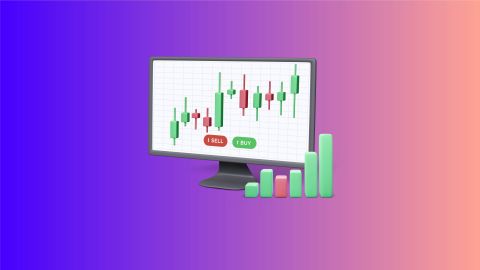Traders in the Indian stock market have different goals and strategies. Some may prefer capitalising on short-term price movements, while others may have a more long-term outlook. These differences have resulted in various trading strategies like intraday and positional trading.
Intraday trading vs. positional trading
Intraday trading and positional trading are two very different strategies. The risks involved, the capital needed, the returns, and the timeline vary significantly. This often results in a very common dilemma about intraday vs. positional trading.
If you’re a newcomer to the markets, you may also be confused about the positional trading vs. intraday trading debate. To better understand which strategy you should choose, check out what these strategies entail and how they differ from one another.
What is intraday trading?
Intraday trading is entering and exiting trade positions within the same trading day. No overnight positions are held. The main aim of intraday trading is to profit from price fluctuations within a single trading day. As a result, traders must monitor the markets continuously throughout the active trading hours. It is also essential to be well-versed in technical analysis to execute intraday trades successfully.
Advantages of intraday trading
One of the most important aspects of resolving the positional trading vs. intraday trading dilemma is understanding each strategy's advantages and limitations. Let’s begin with the benefits that intraday trading offers.
- Potential to earn profits within a short duration
- No exposure to overnight risks
- The benefit of higher leverage offered by stockbrokers
- Multiple trading opportunities in volatile markets
- No requirement for large capital outlays
Disadvantages of intraday trading
Intraday trading also carries certain limitations, which include the following:
- High stress from constant market monitoring
- Increased risk of loss in volatile markets
- Potential for substantial losses due to higher leverage
What is positional trading?
In positional trading, an open position is held for longer than a single trading day — over several days, weeks or even months. Sometimes, a single positional trade may be held for many years to leverage long-term price appreciation. Since the timelines are more diverse in positional trading, you need to be adept at technical and fundamental analysis to use this strategy.
Advantages of positional trading
Like intraday trading, positional trading also has many advantages and certain limitations. Only by getting to know these details can you get more clarity about the intraday vs. positional trading comparison. Check out the benefits of positional trading.
- Less need to monitor the markets constantly
- Opportunity to capture larger market trends and price movements
- Reduced overall brokerage costs due to fewer trades
- More time available for adequate research and analysis
- Opportunity to diversify your investment portfolio across sectors
Disadvantages of positional trading
On the flip side, positional trading also carries some risks, as outlined below:
- Exposure to overnight risks over the long term
- Requirement of a larger capital outlay
- Capital may be locked in for a longer period
Intraday Vs. positional trading: which one should you choose?
To effectively resolve the intraday vs. positional trading dilemma, let’s take a closer look at the differences between intraday and positional trading.
| Particulars | Intraday Trading | Positional Trading |
| Time horizon | Within a single trading day | Days, weeks, months or years |
| Objective | To capitalise on intraday price fluctuations in the market | To capitalise on medium-term to long-term price movements |
| Frequency of trades | Multiple trades within the same trading day | Fewer trades over a longer period |
| Analysis techniques used | Relies heavily on short-term price patterns and technical analysis | Uses technical analysis but relies more on fundamental analysis |
| Risks involved | Intraday price volatility risks | Systemic risks and overnight risks |
| Capital required | Lower capital requirement due to the leverage facility available to traders | Higher capital requirement, especially for long-term positions |
| Tools and indicators used | Intraday charts, moving averages, RSI, MACD, Bollinger Bands, intraday volume, etc. | Long-term moving averages, financial ratios like P/E, P/B, P/S, debt-to-equity ratios, economic data, etc. |
| Returns generated | At the end of a trading day | Over the long term, only after the position is closed |
| Costs Incurred | Potentially higher due to a higher number of trades | Potentially lower due to fewer trades |
This positional trading vs. intraday trading comparison can make it easier to decide which strategy to choose between the two. Ideally, you should choose intraday trading if:
- You are comfortable making quick decisions based on real-time data
- You are interested in profiting from short-term price movements
- You have the time to monitor the markets during the day actively
- You have the discipline and discretion needed to set tight stop-losses
- You can handle the pressure of fast-paced intraday trading
- You have a thorough understanding of how technical analysis works
As for positional trading, you could choose that strategy if:
- You want to capitalise on long-term price changes rather than volatile intraday movements
- You are experienced in reading financial statements, fundamental indicators and economic data
- You prefer to set up a trade and close the position over a few days, weeks, or even months
- You do not have the time to monitor the markets from open to close actively
- You want to experience the benefit of long-term capital appreciation
You are comfortable with having your capital tied up over the long term
Conclusion
This wraps up the positional trading vs. day trading comparison. Consider the differences between intraday and positional trading to make an informed choice between these two strategies. Your choice will also depend on your trading or investment expertise, financial goals and current financial liquidity. Of course, you can also include both of these strategies as a part of your overall trading plan.




